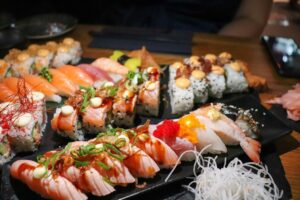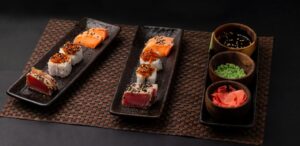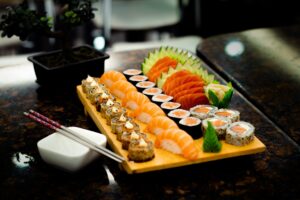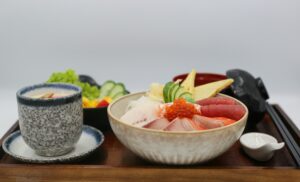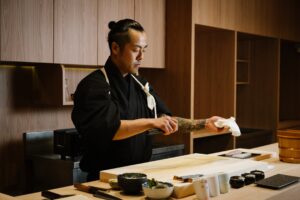
The Art of Japanese Cuisine in Singapore
In Singapore’s extraordinary tapestry of cuisine, where hawker stalls serve chilli crab alongside Michelin-starred establishments, Japanese restaurants have carved out a distinctive space that elevates the city’s already impressive culinary reputation. This multicultural food paradise, where hainanese chicken rice and char kway teow coexist with international fine dining, has become home to over 650 Japanese food outlets that bring an unparalleled level of craftsmanship and philosophical depth to the local dining scene.
Singapore’s position as Asia’s culinary capital stems from its unique ability to preserve authentic traditions while fostering innovation. Within this dynamic ecosystem, Japanese cuisine offers something profoundly different from the vibrant energy of hawker centres or the robust flavors. It provides a contemplative counterpoint to the bustling food stalls, introducing concepts of seasonality, minimalism, and meticulous craftsmanship that have fundamentally influenced how Singaporeans approach fine dining, as previously mentioned in our article Japanese Food in Singapore: A Story of Trust and Tradition.
Japanese Cuisine in Singapore’s Diverse Hawker Centres Food World
In the city-state’s competitive culinary environment, cuisine in Singapore is truly a marvel. Hawkers serving carrot cake (chai tow kway), fried hokkien mee, soy sauce-glazed char kway teow, and fragrant rice cooked for hainanese chicken rice coexist with Japanese establishments offering sushi, sashimi, and more. Singapore’s embrace of Japanese food is reflected in more than 650 Japanese restaurants, izakayas, Indian restaurants, and food stalls scattered from Adam Road Food Centre to Tiong Bahru Market, and high-end districts near City Hall.
Over S$150 million worth of Japanese food products—think fresh fish for sushi, delicate rice cakes, and classic soy sauce—arrive in port every year to stock the kitchens of both rustic ramen joints and dazzling omakase counters. The result? Local taste buds have grown as attuned to the umami-rich notes of miso and dashi as they are to the savory flavors of pork lard-laden bak chor mee or the punchy heat of spicy chili sauce in a bowl of noodles.
What sets Japanese cuisine apart in Singapore is its ability to combine tradition and creativity. Just as food in Singapore reflects multicultural roots (Chinese and Malay influences, coconut milk in curries, woks of stir-fried egg noodles, and fresh ingredients like bean sprouts and spring onions), Japanese chefs utilize classic techniques while improvising with the best tropical and local ingredients.


The Philosophy of Japanese Dining Adapted to Singapore
The translation of Japanese dining philosophy to Singapore’s context reveals fascinating cultural adaptations. Omotenashi, the Japanese concept of selfless hospitality, takes on new dimensions in Singapore’s service-oriented culture. While hawker centres operate on efficiency and familiarity, Japanese restaurants in Singapore practice a more formalized attention to detail that emphasizes anticipating guest needs and creating memorable experiences.
Seasonality presents perhaps the most interesting philosophical challenge. Traditional Japanese cuisine revolves around seasonal ingredients and the celebration of nature’s cycles, but Singapore’s tropical climate eliminates traditional seasons. Japanese restaurants have responded by creating artificial seasons through ingredient sourcing, featuring spring vegetables, summer seafood, autumn mushrooms, and winter preparations according to the Japanese calendar rather than local weather patterns. This commitment to seasonal consciousness introduces Singaporeans to a completely different way of thinking about food and time.
The concept of ichigo ichie—one time, one meeting—finds unique expression in Singapore’s fast-paced environment. While the city’s food culture often revolves around quick satisfaction and repeated favorites, Japanese establishments encourage diners to slow down and appreciate the present moment. This philosophy contrasts sharply with the grab-and-go mentality that characterizes much of eat in Singapore culture.
What Sets Japanese Cuisine Apart in Singapore’s Competitive Culinary Scene
While hawker stalls master the art of wok hei and the perfect balance of dark soy sauce in char kway teow, Japanese kitchens pursue different forms of perfection: the precise temperature of sushi rice, the exact timing of tempura frying, or the careful aging of fish for optimal flavor development.
This attention to detail manifests in ways that distinguish Japanese restaurants from other international cuisines operating in Singapore. The knife skills required for proper sashimi preparation, the years of training needed to master rice preparation, and the understanding of umami development through fermentation and aging processes represent a different approach to culinary mastery than the rapid-fire techniques needed to manage serving soft boiled eggs and thick rice noodles during morning rush.
While delicious dishes like oyster omelette or fish cakes are served primarily for flavor and satisfaction, Japanese cuisine treats every plate as a canvas.

The contemplative nature of a kaiseki meal or the interactive experience of watching a sushi chef work contrasts with the efficient satisfaction provided by most local favorites. This doesn’t diminish the value of quick, satisfying meals like bak kut teh (also known as meat bone tea—despite the name, it contains no tea but refers to a herbal pork bone broth) or chicken curry, but rather expands the spectrum of dining experiences available to Singapore residents and visitors.
While excellent meals can be found at hawker centres for under S$10, and mid-range restaurants offer substantial portions at reasonable prices, Japanese establishments command premium pricing through their emphasis on ingredient quality, preparation technique, and service philosophy.

Ingredient Sourcing: Bringing Japan to Singapore
The logistics of maintaining authentic Japanese cuisine represents one of the most impressive behind-the-scenes operations in the city’s restaurant industry. Unlike local specialties that rely on readily available ingredients—bean sprouts, spring onions, coconut milk, and palm sugar for various dishes—Japanese restaurants must coordinate complex international supply chains to maintain their standards.
Daily operations begin before dawn, with many top Japanese restaurants participating virtually in early morning auctions at Tokyo’s wholesale markets. The commitment to freshness means that premium seafood caught in Japanese waters can appear on Singapore plates within 24-48 hours, maintained through sophisticated cold-chain logistics that ensure optimal quality. This level of dedication to ingredient sourcing exceeds what’s required for most other international cuisines operating in Singapore.
The challenges extend beyond seafood. Authentic Japanese vegetables, specific varieties of rice, traditional fermented products, and seasonal specialties all require careful coordination with Japanese suppliers. The cost implications are significant—premium ingredients can represent 40-50% of a dish’s cost compared to the much lower ingredient costs associated with local favorites like minced pork noodles or fish cake preparations.
Master Chef Craftsmanship in Singapore’s Japanese Restaurants
Many establishments feature chefs who completed extensive apprenticeships in Japan, bringing not just technical skills but deep cultural understanding of Japanese culinary philosophy. These chefs often spend years mastering fundamental techniques before being allowed to handle premium ingredients.
This adaptation process requires balancing authenticity with accessibility, ensuring that sophisticated techniques remain approachable to Singapore diners who might be more familiar with the straightforward preparations found in beloved dishes like chicken broth or poached chicken.
Local Singaporean chefs trained in Japanese techniques bring interesting perspectives to the scene. Having grown up with fried fish, chilli paste, fried tofu, and the bold flavors that characterize much of Singapore’s food culture, these chefs often develop unique sensitivities to how Japanese subtlety can be appreciated by local palates. Their interpretations sometimes bridge traditional Japanese techniques with flavor profiles that resonate with Singapore diners accustomed to more robust seasoning.


Seasonal Awareness in Singapore’s Tropical Climate
Traditional Japanese seasonal ingredients arrive in Singapore according to Japanese agricultural cycles rather than local weather patterns. This approach contrasts with local food culture, where dishes like grilled meat skewers and fresh spring roll are available year-round without seasonal variation.
The educational aspect of seasonal dining represents a significant cultural contribution to Singapore’s food scene. While local favorites like steamed rice cake and tofu puffs are enjoyed year-round, Japanese restaurants introduce the concept that certain foods are optimal only during specific times.
The Art of Intimate Dining: Japanese Restaurant Atmospheres in Singapore
The design philosophy of Japanese restaurants in Singapore creates tranquil islands within the city’s bustling urban environment. While hawker centres thrive on energy and social interaction Japanese establishments prioritize quiet contemplation and focused attention on the meal.
Restaurants use natural materials, controlled lighting, and acoustic design to transport diners away from the sounds and the buzz of typical Singapore dining. This represents a significant departure from the vibrant atmosphere of places like Adam Road Food Centre, where the energy and noise are part of the authentic experience.

While traditional local dining often involves large groups sharing multiple dishes—think families gathering around tables filled with chicken fat rice, curry dipping sauce, and various accompaniments—Japanese counter dining emphasizes individual relationships between chef and diner. This intimate interaction allows for education about techniques, ingredients, and cultural context.
Physical space design reflects these philosophical differences. Japanese restaurants often feature clean lines, natural materials, and minimalist aesthetics that focus attention on the food and preparation process. This contrasts with the functional efficiency of most coffee shops or the decorative abundance found in many traditional restaurants, creating environments specifically designed to enhance appreciation of culinary craftsmanship.
Iconic Japanese Establishments in Singapore’s Food Scene
The city’s Japanese dining scene is layered and diverse, from Michelin-starred omakase temples to bustling ramen joints and specialty bars at Maxwell Food Centre. Iconic names such as Shinji by Kanesaka, Sushi Sato, and Sushi Masa draw global acclaim, each offering distinctive experiences that combine technical excellence with Singapore’s multicultural flair.
The diversity includes specialized concepts: tempura-only bars, yakitori grills, and izakaya-style late-night spots that bring convivial Japanese bar culture to Singapore’s heart. These venues, by focusing meticulously on one type of dish, epitomize the Japanese appreciation for mastery—mirroring the intensity of focus seen at the city’s best hawker stalls perfecting their rice or chili sauce. Many of these dishes are typically served with specific accompaniments or in particular presentation styles, further enhancing their authenticity and the overall dining experience.

Japanese Flavors in Singapore’s Hawker Centers and Street Food
Today, it’s not uncommon to find hawker stalls offering Japanese-inspired takes on local favorites, blending the best of both worlds for adventurous taste buds. For instance, some stalls have reimagined the iconic hainanese chicken rice by marinating the chicken in a delicate mix of soy sauce, sake, and mirin before grilling it to a golden finish. The fragrant rice cooked with coconut milk and pandan leaves is then paired with a zesty chili sauce and a drizzle of dark soy sauce, creating a harmonious fusion that pays homage to both Japanese and Singaporean traditions.
Maxwell Food Centre stands out as a hotspot for these innovative creations, with hawker stalls serving up everything from teriyaki chicken rice to Japanese-style donburi bowls. The street food scene has also embraced Japanese classics like ramen and udon, often featuring local twists such as the addition of spicy chili sauce or fragrant rice as a base.
This cross-cultural exchange not only enriches the variety of food in Singapore but also showcases the city’s openness to new flavors and culinary experimentation. Whether you’re sampling a Japanese-inspired chicken rice or savoring a bowl of noodles infused with umami-rich soy sauce, Singapore’s hawker centers offer a delicious introduction to the art of Japanese fusion street food.
Embarking on the Japanese Dining Journey: A Food Tour
Japanese dining experiences in Singapore range from quick bento sets at hawker stalls to the most exclusive kaiseki courses. The variety mirrors Singapore’s food culture, where each day’s menu could involve breakfast roti prata or a soft boiled egg with kaya toast and sweet milk tea from a stall at Airport Road Food Centre, followed by a Japanese-inspired lunch in the city, and a traditional Peranakan dinner. Along the way, you might enjoy flavorful rice as part of a classic hainanese chicken rice, dip into a spicy sauce to enhance your meal, or cool off with a bowl of shaved ice topped with local ingredients.
This cohesive integration of Japanese cuisine into the broader Singaporean landscape enriches the daily life of residents and entices visitors eager to eat in Singapore.

Explore Japanese Food in Singapore
From rich broths to artful kaiseki, from stalls selling golden brown fried chicken alongside handmade sushi to high-end omakase restaurants importing seasonal treasures from Japan, Japanese cuisine continues to expand the definition of authentic food in Singapore.
As sustainability, technology, and cultural fusion deepen in importance, Japanese establishments remain at the cutting edge, respecting the past while redefining Singapore’s taste for the future.
Singapore’s vibrant food scene is defined by its diversity, with iconic dishes such as fish head curry, oyster omelettes, flat rice noodles in Char Kway Teow, and the tangy chilli sauce that accompanies street favorites like chwee kueh and oyster omelette. Japanese cuisine complements and enriches this rich culinary landscape, adding new layers of flavor and innovation.
Experience the precision and hospitality of Japanese dining—from a hearty bowl of springy egg noodles in a Maxwell Food Centre stall to a contemplative meal orchestrated by a master chef. It is in this interplay—between old and new, local and imported, hawker and haute—that Singapore’s unique culinary soul is found, inviting all who dine to savor the flavor, culture, and innovation that make eating here an adventure in itself.

